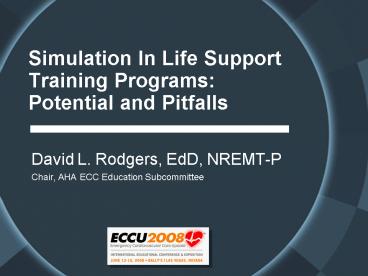Simulation In Life Support Training Programs: - PowerPoint PPT Presentation
1 / 29
Title:
Simulation In Life Support Training Programs:
Description:
Medium-fidelity simulators provide a more realistic representation but lack ... High-fidelity simulation-based training in neonatal nursing. ... Fidelity ... – PowerPoint PPT presentation
Number of Views:128
Avg rating:3.0/5.0
Title: Simulation In Life Support Training Programs:
1
Simulation In Life Support Training Programs
Potential and Pitfalls
David L. Rodgers, EdD, NREMT-P Chair, AHA ECC
Education Subcommittee
2
Disclosure
Dr. Rodgers is a employed as a private curriculum
and instruction consultant. Laerdal Medical is
one of his clients.
3
What we are not going to cover
4
What we are going to cover
- What is Fidelity
- Instructor preparation
- Student preparation
- Administrative preparation
- Research into practice
5
Simulation experience in ACLS and PALS
- Charleston Area Medical Center
- Charleston, West Virginia
- 950 bed tertiary care teaching hospital
- AHA programs run by Life Support
- Training Center
6
Simulation experience in ACLS and PALS
- Started simulation in 2005
- 800 ACLS students per year
- 200 PALS students per year
- 100 Instructors oriented to simulation
Over 20,000 ACLS and PALS Simulations Conducted
Special acknowledgement to Barbara McKee, David
Matics, Chris Battlo
7
Simulation and Life Support Training A good
match?
As sites gain access to an advanced patient
simulator, the training and testing phases of
ACLS are becoming more realistic. There are
several advantages to the use of this technology,
particularly with regard to a course such as ACLS
(p. 399).
Franklin GA. (2004). Simulation in life support
protocols, Practical Health Care Simulations.
Edited by Loyd GE, Lake CL, and Greenburg RB,
Philadelphia, PA, Elsevier/Mosby, p. 393-404.
8
Simulation and Life Support Training A good
match?
Simulation could be an effective strategy and
tool for teaching advanced cardiac life support
(p. 174).
Schumacher L. (2004). Simulation in nursing
education Nursing in a learning resource center,
Practical Health Care Simulations. Edited by Loyd
GE, Lake CL, and Greenburg RB, Philadelphia, PA,
Elsevier/Mosby, p. 169-175..
9
ACLS then
10
ACLS now
11
Fidelity
Fidelity is the extent to which the appearance
and behaviour of the simulator/simulation match
the appearance and behaviour of the simulated
system (p. 23).
Maran, N. J., Glavin, R. J. (2003). Low- to
high-fidelity simulation - A continuum of medical
education? Medical Education, 37 22-28.
12
Fidelity
Low-fidelity simulators are focused on single
skills and permit learners to practice in
isolation. Medium-fidelity simulators provide a
more realistic representation but lack sufficient
cues for the learner to be fully immersed in the
situation. High-fidelity simulators provide
adequate cues to allow for full immersion and
respond to treatment interventions.
Yaeger, K. A., Halamek, L. P., Coyle, M., Murphy,
A., Anderson, J., Boyle, K., et al. (2004).
High-fidelity simulation-based training in
neonatal nursing. Advances in Neonatal Care, 4,
326-331.
13
Fidelity
a system that presents a fully interactive
patient and an appropriate clinical work
environment (p. i5).
Gaba, D. (2004). The future vision of simulation
in health care. Quality and Safety in Health
Care, 13, i2-i10.
14
Fidelity
Equipment/Physical
15
Fidelity
Equipment
Task
16
Fidelity
Equipment
Task
Environmental
17
Fidelity
Equipment
Task
Environmental
Psychological
18
Which is more important for most learning events
?
12
A high-fidelity simulator
88
A high-fidelity environment
Dieckmann, P. (2008). How much realism is needed
in medical simulation? Presentation at the
International Meeting on Simulation in
Healthcare, San Diego, Ca.
19
(No Transcript)
20
Instructor Perspective
The simulator is just a tool for the instructor
to use to accomplish learning objectives more
effectively.
The instructor is still the most critical
resource in the room.
21
Instructor Perspective
- Teaching Style
- Objective Driven
- Technology
- Debriefing Skills
- Workload
- Realistic Scenario
22
Student Perspective
- Orientation
- Expectations for performance
- Intimidated by technology
- Quickly accepted
23
Administrative Perspective
- Cost (Capital and Operating)
- Scheduling (Push-back from other users)
- Return on Investment
24
Outcomes in Life Support Training
Wayne DB, et al. Mastery learning of Advanced
Cardiac Life Support skills by Internal Medicine
residents using simulation technology and
deliberate practice. Journal of General Internal
Medicine 2006 21 p. 251. Wayne DB, et al.
Simulation-based training of internal medicine
residents in Advanced Cardiac Life Support
protocols A randomized trial. Teaching and
Learning in Medicine 2005 17 p. 202-208. Wayne
DB, et al. Simulation-based education improves
quality of care during cardiac arrest team
responses at an academic teaching hospital A
case-control study. Chest 2008 133 p. 56-61.
25
Outcomes in Life Support Training
Wayne DB, et al. Simulation-based education
improves quality of care during cardiac arrest
team responses at an academic teaching hospital
A case-control study. Chest 2008 133 p. 56-61.
26
Outcomes in Life Support Training
- Senior nursing students with little to no
experience in ACLS - First group ACLS with low-fidelity manikins
- Second group ACLS with high-fidelity manikins
Both low- and high-fidelity did equally well at
basic skills and activities in the first minutes
of a simulated cardiac arrest
Students in the high-fidelity group did better as
the case grew longer and became more complex.
Rodgers, D. L. (2007). The effect of
high-fidelity manikin-based human patient
simulation on educational outcomes In Advanced
Cardiovascular Life Support courses. Doctoral
Dissertation Marshall University, Huntington,
W.Va.
27
Summary
The use of high-fidelity simulation is
efficacious in advanced Life support courses such
as ACLS and PALS. A high-fidelity simulation
includes manikin, environment, and a realistic
scenario. Both instructors and students need
to be adequately prepared for teaching/learning
in a high-fidelity simulation. Not everything
needs to be taught in a high-fidelity simulation.
Some objectives are better suited to task
trainers while others benefit from a higher
fidelity simulation.
28
Questions
David L. Rodgers, EdD, NREMT-P Healthcare
Simulation Strategies 3501 MacCorkle Ave. SE
120 Charleston, WV 25304 304.444.1078 dave.rodge
rs_at_sim-strategies.com
29
(No Transcript)































